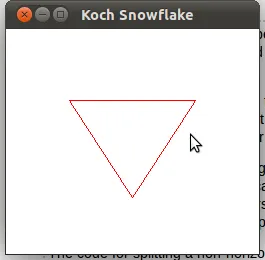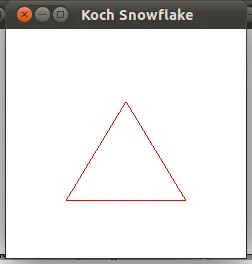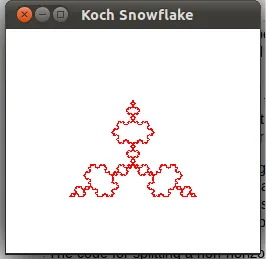编辑:我不确定这是否应该是一个新问题,因此现在我只是更新这个问题。除非我改变原始坐标,否则雪花图案现在能够正确生成。例如,如果我的原始三角形像图片1一样,进行5次迭代后的结果如图片2所示:


然而,如果我的原始三角形有任何不同,例如图片3,结果会有偏差:


我再次认为问题出在法线上,但我真的很迷惑。我已经试了几个小时来找出正确的公式,但我没有取得任何进展。由于新三角形经常被翻转,我怀疑 atan 在应该给我正值时给了我负值。有没有数学方法可以解决这个问题?非常感谢您的帮助!
我的代码(去掉了openGL部分,因为我认为它们不是问题):
const int NumTimesToSubdivide = 5;
const int NumSegments = 3072; // 3x4^n lines generated {3, 12, 48, 192, 768, 3072..}
const int NumVertices = NumSegments * 2; // 2 vertices for each segment
vec2 arrayA[NumVertices];
vec2 arrayB[NumVertices];
//----------------------------------------------------------------------------
void koch( const vec2 &a, const vec2 &b, vec2 * verts) {
/* Calculate new segments.
* v1
* /\
* / \
* / \
* a----/ \----b
* v0 v2
*/
vec2 v0;
vec2 v1;
vec2 v2;
GLfloat distance(sqrt(pow(b.x - a.x, 2) + pow(b.y - a.y,2)));
GLfloat deltaX = abs(b.x - a.x);
GLfloat deltaY = abs(b.y - a.y);
GLfloat normalX((b.x - a.x) / deltaX);
GLfloat normalY((b.y - a.y) / deltaY);
GLfloat theta = atan2(b.y - a.y, b.x - a.x) - M_PI / 3.0;
cout << " theta = " << theta << endl;
/*************************
* Find trisection points
*************************/
// horizontal line _____________
if(a.y == b.y) {
vec2 temp0(a.x + (deltaX * normalX / 3) , a.y);
vec2 temp2(a.x + (deltaX * normalX * 2/3) , a.y);
vec2 temp1((a.x + b.x) / 2, a.y + distance * sin(theta) / 3);
v0 = temp0;
v2 = temp2;
v1 = temp1;
}
// |
// vertical line |
// |
else if(a.x == b.x){
vec2 temp0(a.x , (a.y + (deltaY * normalY / 3)));
vec2 temp2(a.x , (a.y + (deltaY * normalY * 2/3)));
vec2 temp1(a.x + distance * cos(theta) / 3 , (a.y + b.y) / 2);
v0 = temp0;
v2 = temp2;
v1 = temp1;
}
// slope != 0 && slope != 1
else {
vec2 temp0(a.x + (deltaX * normalX / 3), a.y + (deltaY * normalY / 3));
vec2 temp2(a.x + (deltaX * normalX * 2/3), a.y + (deltaY * normalY * 2/3));
// Andrew is the greatest!
vec2 temp1(temp0.x + distance * cos(theta) / 3,
temp0.y + distance * sin(theta) / 3);
v0 = temp0;
v2 = temp2;
v1 = temp1;
}
verts[0] = a;
verts[1] = v0;
verts[2] = v0;
verts[3] = v1;
verts[4] = v1;
verts[5] = v2;
verts[6] = v2;
verts[7] = b;
}
//----------------------------------------------------------------------------
void divide_line( const vec2& a, const vec2& b, const vec2& c, int n )
{
// arrayA = {a, b, b, c, c, a} i.e., the sides of the initial triangle
arrayA[0] = a;
arrayA[1] = b;
arrayA[2] = b;
arrayA[3] = c;
arrayA[4] = c;
arrayA[5] = a;
// If at least one iteration:
if(n > 0) {
// The current iteration, starting with 0
int currentIteration = 1;
// Do for every iteration from 0 - n:
while (currentIteration <= n) {
int i;
int j = 0;
int size = 3 * 2 * (pow(4,currentIteration-1));
// Call koch() for each pair of vertices in arrayA
for(i = 0; i < size; i = i+2) {
vec2 verts[8];
koch(arrayA[i], arrayA[i+1], verts);
// Store each vertex in arrayB
int k;
for(k = 0; k <= 7; k++)
arrayB[j++] = verts[k];
}
// Copy arrayB to arrayA for next iteration.
size = 3 * 2 * pow(4, currentIteration);
for(i = 0; i < NumVertices; i++) {
arrayA[i] = arrayB[i];
}
// Increase count of currentIteration.
currentIteration++;
}
} else
printf("The number of iterations must be >= 0.\n");
}
我目前正在尝试用C++实现Koch曲线。我已经基本实现了它。我需要解决的问题基本上有三种情况:需要将要断成四段的线段是水平的、垂直的或其他情况。
问题在于,当程序计算出线段的新顶点时,可能存在两种可能性:三角形可以面向“上”或者三角形可以面向“下”。我试图通过标准化矢量来考虑这一点,但我可能做错了,或者还有其他一些小错误。下面的图片是两个例子;两个例子都有 3个迭代的分形。
非水平和非垂直线段拆分的代码如下,因为三角形似乎对于垂直/水平线段面向正确的方向:
if(a.x == b.x) {
...
}
else if (a.y == b.y) {
...
}
// slope != 0 && slope != 1
else {
GLfloat deltaX = abs(b.x - a.x);
GLfloat deltaY = abs(b.y - a.y);
vec2 temp0(a.x + (deltaX * normalX / 3), a.y + (deltaY * normalY / 3));
vec2 temp2(a.x + (deltaX * normalX * 2/3), a.y + (deltaY * normalY * 2/3));
GLfloat dist(sqrt(pow(temp2.x - temp0.x, 2) + pow(temp2.y - temp0.y,2)));
GLfloat theta = (a.x - b.x)/ (b.y - a.y);
vec2 temp1((a.x + b.x) / 2 + dist * cos(atan(theta)) ,
(a.y + b.y) / 2 + dist * sin(atan(theta)));
v0 = temp0;
v2 = temp2;
v1 = temp1;
}
a和b是线段的向量。normalX和normalY是:
GLfloat normalX((b.x - a.x) / (abs(b.x - a.x)));
GLfloat normalY((b.y - a.y) / (abs(b.y - a.y)));
有什么想法可以解决这个问题吗?